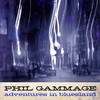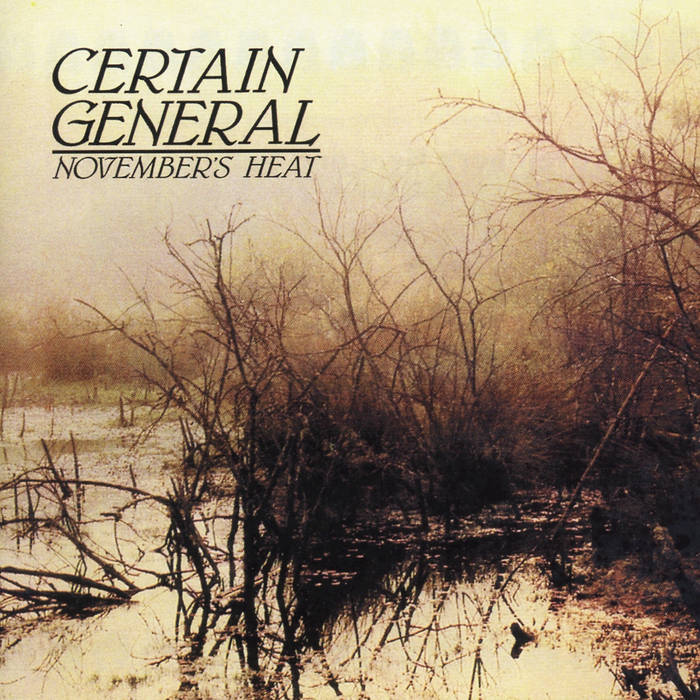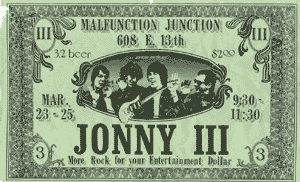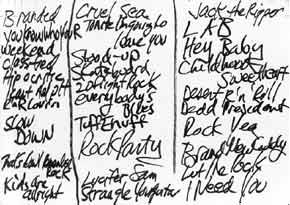
|
|
|
|
|
Phil Gammage "Adventures in Bluesland" Phil Gammage "Kneel to the Rising Sun" 20th Anniversary Edition originally released on New Rose (France) The Scarlet Dukes "Rogue Escapade" Jump blues/swing  Certain General "November's Heat" 1985's classic NYC post-punk LP Phil Gammage "Tracks of Sound" Edgy downtown jazz |
| DENVER'S PUNK SCENE: DEAD OR ALIVE from THE METROPOLITAN JUNE 13, 1979 By Lou Chapman The following is a Denver pre-eulogy. Although it is in remembrance of one musically maverick group, it is also dedicated to the memory of broader bases of neophyte rebels who raised their beamish heads in Denver, only to find the seasons were bad, the ground was too mushy or too damn frozen; they could not run with the ball. The majority of us only discover such subterraneans — jazz, coffee house theater, panters and poets and dancers — ex post facto: after the media has provided the necessary background and homogenization. And it happens, before the people involved at the nebuluous, indefinable beginning knew what was happening around them. They could only sense: "Shit, it's all changed, isn't it?"
On the northwest of the Capitol Hill intersection of 13th Avenue and Pearl Street is Howerd's (that is the correct spelling) Liquors, with its 1950s neon sign running vertically on the stucco wall above the front door and its portable TV above the sales counter always on. The 600 block of 13th Avenue, east to Washington Street, is a cheap arcade of empty or broken two-bit booths: fitness centers, a used records store, a cash discount club, a beauty salon and a laundramat and a restaurant and a three-story Public Service building housing a quite transformer. In the middle of the block is the Malfunction Junction, announcing its current attraction with two-feet-tall letters made from newspaper print stapled to the boarded-over windows. The Malfunction Junction was once the heart of this tired block, though it was usually sedate. But the heart — occasionally, rarely — would wake up, receive a bit of adrenaline, and throb primitively with a steady, strong pulse full of oxygen and blood, pumping music out the doors of the Malfunction Junction, pumping live down the street and alley. On those weekend nights, when the block was hopping and its erratic heart racing, it was even money the adrenaline was the Jonny Three. When the Jonny Three performed at the Malfunction (the last name is dropped in conversation), no one would mind shelling out relatively higher cover prices or being packed in wall to wall, sweltering and smoke-eyed. The pool players had a hell of a time getting off their shots before having their elbows knocked by someone passing by on his way to or from the restroom in the bar. The only common denominator among the crowd was the red stamp on the back of everyone's hands. The management at the door marked you in case you wanted to leave and return ... maybe to get over to Howerd's before midnight, when both Howerd's and the Malfunction must by law shut down (the Malfunction is a 3.2 establishment). There was no dress pattern on nights when the Jonny Three or similar groups played, except for a tendency toward styles from the 1950s: men's pleated pants and girls' tight sweaters, wide lapels and narrow neckties (Millie's It'll Do, a second-hand shop down the street, is all out of narrow neckties), and a number of guys wearing T-shirts, tight pants, and nouveau-ducktail haircuts, looking as if they are costumed for "Rebel Without a Cause." Then there were the people who — without having to go home to change their clothes or their manners — could have left the Malfunction and zipped out to Glendale or down the stree to "David's" for a little disco. The music was too loud to converse without yelling or carefully articulating your words directly into the ear of your listener. But all around, with their feet stomping in rhythm, their heads bobbing in rhythm, and their 3.2 beer going down in rhythm, people were talking with no more strain than if they were hanging out at the card catalog of the local library. "I guess you just don't think of it as loud when you want to talk," one girl explained. Her foot never stopped tapping on the floor; her jaws never stopped chomping on her chewing gum. The music rolled over and oever itself, like a mass chant from 70,000 football fans in 4/4 time at the speed of old Chuck Berry songs: Block that kick, hey! — faster — Block that kick, hey! It was not muddied and confused with the acid-rock, wired, feedback noise of the late 1960s. It was straight rock and roll. It was the enthusiasm of the foot-stomping Dave Clark Five, shot up with a load of dynamite. It was Buddy Holly and Gene Vincent (whose faces appeared on lapel buttons here) drunk one night, saying "Let's just blast one for a goddamned change!" The words, despite the amplified voice of 24-year-old lead singer and guitarist Kenny Vaughan, were unintelligible until after multiple exposures.
Each song built quickly, each measure feeding the next, the almost syncopated, always varied drumming never letting up, until finally, having filled the volatile room, it all came crash-landing like a jackhammer hitting a 4,200 volt underground power line. A 15-second pause, an audible "one, two, three, four," and they were into the next one. Just as they didn't play any slow ballads or laggardly love songs, they wouldn't mess with orchestrated fade-ins or cute fade-outs. There didn't seem to be any time for that type of music or antics. It would have been cheating. Even at home it was rock and roll straight forward and alive. The Jonny Three originated in Littleton and still live there in their garage-turned two-room bungalow-turned rehersal studio (also Smith's home and flophouse for the group), located just behind the Velour Hardware Store on Main Street, their time has been spent listening to and playing music. "Wait until you guys hear this one," Smith said, "We've got to learn this one." He put down his Miller's beer and went out of the bedroom/kitchen into the livingroom/studio to but on the record. He came back into the room, leaned against the door frame — with five people in the room there was no place left to sit — and the tune started blasting out, rattling the empty beer cans stacked against the refrigerator next to the window covered with someone's jacket. Then eyes passed from one to the other with the recognition of something they must share. They passed around the bottle of Jack Daniels, each took another hit from his beer, and all listened carefully to the Monkee's version of "Mary, Mary." The song ended and they all smiled. Smith jumped up and again ran into the next room. The Collins Kids, circa 1956, rocked the handbill-and-poster-covered walls with "Hop, Skip, and a Jump." Gassaway, 25 years old, told the story of the Collins Kids, ages 12 and 15 when they hit the big time, who taught the younger one to play the guitar like a demon, where they lived, what happened to them, the whole works. It's been a passion with the Jonny Three, this almost maniacal, certainly fanatical love for background of the lives of the people who made all the music that has turned them on. One Saturday night, after a party where they had played (the Malfunction, depite having other live music that night, was dead) they sat around at 3:00 a.m., listening to the Johnny Burnette Trio. Leuthauser, socially laconic, if not withdrawn, (playing his electric bass he becomes an extension of its circuitry like a live wire on stage) explained the rock-a-billy style of the Burnette Trio. He told in quite tones how it is more pure and earlier than Elvis's first attempts, how it changed when they became commercial later in the 1950s, how they "sort of sold out." Leuthanser is 29 years old. And this love of pure, original rock and roll — as a matter or lifeblood, not merely as an interest — on certain weekend nights once upon a time found its way to the Malfunction Junction. The 25-foot dance floor would become crammed with sweating bodies doing the Pogo or the Epileptic (the names imply the movements they mimicked), or the bodies simply jumped up and around. It looked like a 25-foot frying pan with a bunch of human-size French fries dropped into hot oil. "You just gotta move with it, you know," said one adolescent with stringy black hair and stooped shoulder taking at least four inches from his six-foot frame, wearing red and white striped pants that ended inches above his ankles, a T-shirt too small for even his skin-and-bones build, and sunglasses with wide white plastic frames. He dances every dance, whether or not he can find a partner. He dances like a marionette caught in a Waring food blender. The Jonny Three did two encores that night: "Highway 66" and "Little Latin Lupe Lu." The lights came on bright, and the crowd ambled out onto 13th Avenue, as the manager of the Malfunction tried wearily to pawn off his last six-packs of 3.2 beer. The crowd fragmented, part of it going past Mutual Cleaners; part going the other way, past Sisko's Cafe and Wax Trax. Across the street, humming silently in the night, was the red brick utilities building with its one-foot square signs warning the passersby on the 600 block of 13th Avenue: High Voltage. |




 The Malfunction Junction has gone country-rock, the Jonny Three play mostly out of town or at their home, and Peaches Records and Tapes is selling Joe Jackson as if he were Donny Osmond.
The Malfunction Junction has gone country-rock, the Jonny Three play mostly out of town or at their home, and Peaches Records and Tapes is selling Joe Jackson as if he were Donny Osmond.
 The songs of the Jonny Three were short, three minutes at the maximum, like the '50s and early '60s. They each started with a bash and a jolt from the whole group (Vaughan, drummer Leroy Smith, bassist Nic Leuthauser, and saxophonist and keyboards player Miles Gassaway), or with a quick Chuck Berry-style riff from Vaughan, or an introductory, pace-setting, tom-tom measure or two from Smith.
The songs of the Jonny Three were short, three minutes at the maximum, like the '50s and early '60s. They each started with a bash and a jolt from the whole group (Vaughan, drummer Leroy Smith, bassist Nic Leuthauser, and saxophonist and keyboards player Miles Gassaway), or with a quick Chuck Berry-style riff from Vaughan, or an introductory, pace-setting, tom-tom measure or two from Smith.